
- Homepage
- Certification
- Composition
- Denomination
- Ae Prutah (34)
- Ae3 (14)
- Antoninianus (102)
- Ar Denarius (41)
- Aurelianianus (12)
- Aureus (145)
- Bi Double Denarius (24)
- Bi Nummus (22)
- Centenionalis (16)
- Cistophorus (24)
- Denarius (1266)
- Double Denarius (63)
- Dupondius (16)
- Nummus (119)
- Prutah (27)
- Quadrigatus (13)
- Sestertius (126)
- Siliqua (15)
- Solidus (169)
- Tetradrachm (21)
- Other (602)
- Era
- Ruler
- Antoninus Pius (52)
- Augustus (141)
- Caracalla (53)
- Constantine I (57)
- Constantine Ii (29)
- Domitian (58)
- Gallienus (37)
- Gordian Iii (62)
- Hadrian (100)
- Marcus Aurelius (67)
- Nero (113)
- Nerva (31)
- Philip I (66)
- Septimius Severus (35)
- Severus Alexander (69)
- Theodosius Ii (32)
- Tiberius (69)
- Trajan (97)
- Trajan Decius (28)
- Vespasian (76)
- Other (1599)
- Year
Balbinus Pupienus & Gordian III as Caesar Ancient Aegeae Roman Coin NGC i81680
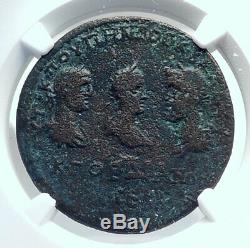
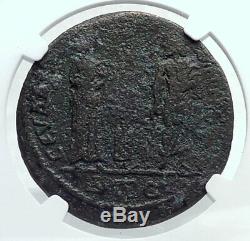
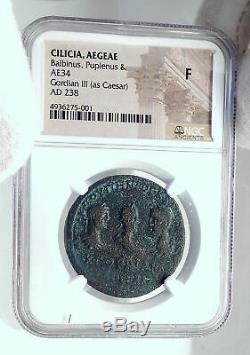
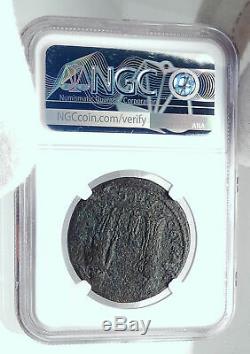
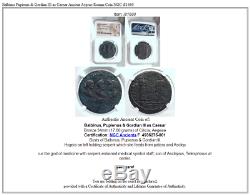


Item: i81680 Authentic Ancient Coin of. Balbinus, Pupienus & Gordian III as Caesar Bronze 34mm (17.60 grams) of Cilicia, Aegeae Certification: NGC Ancients. F 4936275-001 Busts of Balbinus, Pupienus & Gordian III. Hygeia on left holding serpent which she feeds from patera and Asclepius the god of medicine with serpent-entwined medical symbol staff; son of Asclepius, Telesphorus at center.
In Greek and Roman mythology, Hygieia , or Hygeia , was a daughter of the god of medicine, Asclepius. She was the goddess of health, cleanliness and sanitation and afterwards, the moon. She also played an important part in her father's cult.
While her father was more directly associated with healing, she was associated with the prevention of sickness and the continuation of good health. Her name is the source of the word "hygiene". At Athens, Hygieia was the subject of a local cult since at least the 7th century BC.
"Athena Hygieia" was one of the cult titles given to Athena, as Plutarch recounts of the building of the Parthenon (447-432 BC). However, the cult of Hygieia as an independent goddess did not begin to spread out until the Delphic oracle recognized her, and after the devastating Plague of Athens (430-27 BC) and in Rome in 293 BC. In the second century AD, Pausanias noted the statues both of Hygieia and of Athena Hygieia near the entrance to the Acropolis of Athens. Hygieia's primary temples were in Epidaurus, Corinth, Cos and Pergamon. Pausanias remarked that, at the Asclepieion of Titane in Sicyon (founded by Alexanor, Asclepius' grandson), statues of Hygieia were covered by women's hair and pieces of Babylonian clothes. According to inscriptions, the same sacrifices were offered at Paros. Ariphron, a Sicyonian artist from the 4th century BC wrote a well-known hymn celebrating her.Statues of Hygieia were created by Scopas, Bryaxis and Timotheus, among others, but there is no clear description of what they looked like. She was often depicted as a young woman feeding a large snake that was wrapped around her body or drinking from a jar that she carried. These attributes were later adopted by the Gallo-Roman healing goddess, Sirona. Hygieia was accompanied by her brother, Telesphorus.
"Hygieia" was used as a greeting among the Pythagoreans. Asclepius is the god of medicine and healing in ancient Greek religion. Asclepius represents the healing aspect of the medical arts; his daughters are Hygieia ("Health"), Iaso ("Medicine"), Aceso ("Healing"), and Panacea ("Universal Remedy"). The rod of Asclepius, a snake-entwined staff, remains a symbol of medicine today, although sometimes the caduceus, or staff with two snakes, is mistakenly used instead. He was associated with the Roman/Etruscan god Vediovis.
He was one of Apollo's servants. The rod of Asclepius , also known as the asklepian , is an ancient symbol associated with astrology, the Greek god Asclepius and with medicine and healing. It consists of a serpent entwined around a staff. The name of the symbol derives from its early and widespread association with Asclepius, the son of Apollo, who was a practitioner of medicine in ancient Greek mythology.His attributes, the snake and the staff, sometimes depicted separately in antiquity, are combined in this symbol. The Rod of Asclepius also represents the constellation Ophiuchus (or Ophiuchus Serpentarius), the thirteenth sign of the sidereal zodiac.
Hippocrates himself was a worshipper of Asclepius. In Greek mythology, Telesphorus (or Telesphoros ;) was a son of Asclepius. He frequently accompanied his sister, Hygieia. He was a dwarf whose head was always covered with a hood or cap. He symbolized recovery from illness, as his name means "the accomplisher" or "bringer of completion" in Greek. Representations of him are found mainly in Anatolia and along the Danube. Telesphorus is assumed to have been a Celtic god in origin, who was taken to Anatolia by the Galatians in the 3rd century BC, where he would have become associated with the Greek god of medicine, Asclepius, perhaps in Pergamon, an Asclepian cult center. And spread again to the West due to the rise of the Roman Empire, in particular during the 2nd century AD, from the reign of Hadrian, after Epidaurus, the main center of the cult of Asclepius, had adopted him. Gordian III (Latin: Marcus Antonius Gordianus Pius Augustus ; 20 January 225 AD - 11 February 244 AD) was Roman Emperor from 238 AD to 244 AD.At the age of 13, he became the youngest sole legal Roman emperor throughout the existence of the united Roman Empire. Gordian was the son of Antonia Gordiana and an unnamed Roman Senator who died before 238. Antonia Gordiana was the daughter of Emperor Gordian I and younger sister of Emperor Gordian II. Very little is known of his early life before his acclamation.
Gordian had assumed the name of his maternal grandfather in 238 AD. In 235, following the murder of Emperor Alexander Severus in Moguntiacum (modern Mainz), the capital of the Roman province Germania Superior, Maximinus Thrax was acclaimed Emperor. In the following years, there was a growing opposition against Maximinus in the Roman senate and amongst the majority of the population of Rome. In 238 a rebellion broke out in the Africa Province, where Gordian's grandfather and uncle, Gordian I and II, were proclaimed joint emperors. This revolt was suppressed within a month by Cappellianus, governor of Numidia and a loyal supporter of Maximinus Thrax. The elder Gordians died, but public opinion cherished their memory as peace-loving and literate men, victims of Maximinus' oppression. Meanwhile, Maximinus was on the verge of marching on Rome and the Senate elected Pupienus and Balbinus as joint emperors. These senators were not popular men and the population of Rome was still shocked by the elder Gordian's fate, so the Senate decided to take the teenager Gordian, rename him Marcus Antonius Gordianus like his grandfather, and raise him to the rank of Caesar and imperial heir. Pupienus and Balbinus defeated Maximinus, mainly due to the defection of several legions, particularly the II Parthica , who assassinated Maximinus. However, their joint reign was doomed from the start with popular riots, military discontent and an enormous fire that consumed Rome in June 238. On July 29, Pupienus and Balbinus were killed by the Praetorian Guard and Gordian proclaimed sole emperor.Decimus Caelius Calvinus Balbinus c. 165 - 29 July 238 was Roman Emperor with Pupienus for three months in 238, the Year of the Six Emperors. Not much is known about Balbinus before his elevation to emperor. It has been conjectured that he descended from Publius Coelius Balbinus Vibullius Pius, the consul ordinarius of 136 or 137, and wife Aquilia. If this were true, he was also related to the family of Q.
Pompeius Falco, which supplied many politicians of consular rank throughout the 3rd century, and to the 1st-century politician, engineer and author Julius Frontinus, as well as a descendant of a first cousin of Trajan. He was a patrician from birth, and was the son (either by birth or adoption) of... Caelius Calvinus, who was legate of Cappadocia in 184. According to Herodian he had governed provinces, but the list of seven provinces given in the Historia Augusta , as well as the statement that Balbinus had been both Proconsul of Asia and of Africa, are likely to be mere invention.He had certainly been twice consul; his first consulate is not certainly known but is believed to have been about 203 or in July 211; he was consul for the second time in 213 as colleague of Caracalla, which suggests he enjoyed that emperor's favour. According to Edward Gibbon (drawing upon the narratives of Herodian and the Historia Augusta). Balbinus was an admired orator, a poet of distinguished fame, and a wise magistrate, who had exercised with innocence and applause the civil jurisdiction in almost all the interior provinces of the empire. His birth was noble, his fortune affluent, his manners liberal and affable.
In him, the love of pleasure was corrected by a sense of dignity, nor had the habits of ease deprived him of a capacity for business. The two colleagues [Pupienus and Balbinus] had both been consul (Balbinus had twice enjoyed that honourable office), both had been named among the twenty lieutenants of the senate; and, since the one was sixty and the other seventy-four years old, they had both attained the full maturity of age and experience. When the Gordians were proclaimed Emperors in Africa, the Senate appointed a committee of twenty men, including Balbinus, to co-ordinate operations against Maximinus Thrax. On the news of the Gordians' defeat, the Senate met in closed session in the Temple of Jupiter and voted Pupienus and Balbinus as co-emperors, though they were soon forced to co-opt the child Gordian III as a colleague.Balbinus was probably in his early seventies: his qualifications for rule are unknown, except presumably that he was a senior senator, rich and well-connected. While Pupienus marched to Ravenna, where he oversaw the campaign against Maximinus, Balbinus remained in Rome, but failed to keep public order.
The sources suggest that after Pupienus's victorious return following Maximinus' death, Balbinus suspected Pupienus of wanting to supplant him, and they were soon living in different parts of the Imperial palace, where they were later assassinated by disaffected elements of the Praetorian Guard. Pupienus Latin: Marcus Clodius Pupienus Maximus Augustus ; born c. 165/170 - 29 July 238, also known as Pupienus Maximus , was Roman Emperor with Balbinus for three months in 238, during the Year of the Six Emperors. The sources for this period are scant, and thus knowledge of the emperor is limited.
In most contemporary texts Pupienus is referred by his cognomen "Maximus" rather than by his second nomen (family name) Pupienus. The Historia Augusta , whose testimony is not to be trusted unreservedly, paints Pupienus as an example of advancement through the cursus honorum due to military success.It claims he was the son of a blacksmith, was adopted by one Pescennia Marcellina (otherwise unknown), and who started his career as a Centurio primus pilus before becoming a Tribunus Militum, and then a Praetor. He was in fact part of the aristocracy, albeit a minor one, and possibly quite recently. Hailing from the Etruscan city of Volterra, it has been speculated that Pupienus was the son of Marcus Pupienus Maximus, a Senator who was the first member of his family to enter the Senate, and wife Clodia Pulchra.
Pupienus's career was impressive, serving a number of important posts during the reign of the Severan dynasty throughout the late 2nd and early 3rd centuries. This included assignment as Proconsul of the senatorial propraetorial provinces of Bithynia et Pontus, Achaea, and Gallia Narbonensis. He was later assigned as imperial legate to one of the German provinces, most probably after his first suffect consulship, circa 207 AD. During his time as governor, he was quite popular and scored military victories over the Sarmatians and German tribes. In 234, during the last years of Severus Alexander's reign, he was installed as Consul for the second time.
In that same year he was also appointed Urban Prefect of Rome and gained a reputation for severity, to the extent that he became unpopular with the Roman mob. When Gordian I and his son were proclaimed Emperors in Africa, the Senate appointed a committee of twenty men, including the elderly Senator Pupienus, to co-ordinate operations against Maximinus until the arrival of the Gordians. On the news of the Gordians' defeat and deaths, however, the Senate met in closed session in the Temple of Jupiter Capitolinus and voted for two members of the committee to be installed as co-emperors - Pupienus and Balbinus. Unlike the situation in 161 with Marcus Aurelius and Lucius Verus, both emperors were elected as pontifices maximi , chief priests of the official cults. According to Edward Gibbon (drawing on the narratives of Herodian and the Historia Augusta), the choice was sensible, as.
The mind of Maximus [Pupienus] was formed in a rougher mould [than that of Balbinus]. By his valour and abilities he had raised himself from the meanest origin to the first employments of the state and army. His victories over the Sarmatians and the Germans, the austerity of his life, and the rigid impartiality of his justice whilst he was prefect of the city, commanded the esteem of a people whose affections were engaged in favour of the more amiable Balbinus. The two colleagues had both been consul... And, since the one was sixty and the other seventy-four years old, they had both attained the full maturity of age and experience.However, factions within the Senate who had hoped to profit from the accession of the Gordians manipulated the people and the Praetorian Guard to agitate for the elevation of Gordian III as their imperial colleague. Balbinus, in the meantime, had failed to keep public order in the capital. The sources suggest that Balbinus suspected Pupienus of using his newly acquired German bodyguard to supplant him, and they were soon living in different parts of the Imperial palace. This meant that they were at the mercy of disaffected elements in the Praetorians, who resented serving under Senate-appointed emperors, and now plotted to kill them.
Pupienus, becoming aware of the threat, begged Balbinus to call for the German bodyguard. Balbinus, believing that this news was part of a plot by Pupienus to have him assassinated, refused, and the two began to argue just as the Praetorians burst into the room.
Both emperors were seized and dragged back to the Praetorian barracks where they were tortured and brutally hacked to death in the bath house. Pupienus had at least three children. His eldest son, Tiberius Clodius Pupienus Pulcher Maximus, was a Consul Suffectus c. 235, and patron of the town of Tibur outside Rome.
His youngest son, Marcus Pupienus Africanus Maximus, was Consul Ordinarius in 236 as colleague of the Emperor Maximinus Thrax. This run of consulships in the family, across the reigns of Severus Alexander and Maximinus Thrax, show that the family was influential and in high favour. Pupienus also had a daughter, named Pupiena Sextia Paulina Cethegilla, wife of Marcus Ulpius Eubiotus Leurus.
World-renowned expert numismatist, enthusiast, author and dealer in authentic ancient Greek, ancient Roman, ancient Byzantine, world coins & more. Ilya Zlobin is an independent individual who has a passion for coin collecting, research and understanding the importance of the historical context and significance all coins and objects represent. Send me a message about this and I can update your invoice should you want this method.Getting your order to you, quickly and securely is a top priority and is taken seriously here. Great care is taken in packaging and mailing every item securely and quickly. What is a certificate of authenticity and what guarantees do you give that the item is authentic? You will be very happy with what you get with the COA; a professional presentation of the coin, with all of the relevant information and a picture of the coin you saw in the listing.
Additionally, the coin is inside it's own protective coin flip (holder), with a 2x2 inch description of the coin matching the individual number on the COA. Whether your goal is to collect or give the item as a gift, coins presented like this could be more prized and valued higher than items that were not given such care and attention to.
When should I leave feedback? Please don't leave any negative feedbacks, as it happens sometimes that people rush to leave feedback before letting sufficient time for their order to arrive.
The matter of fact is that any issues can be resolved, as reputation is most important to me. My goal is to provide superior products and quality of service. How and where do I learn more about collecting ancient coins? Visit the Guide on How to Use My Store. For on an overview about using my store, with additional information and links to all other parts of my store which may include educational information on topics you are looking for. The item "Balbinus Pupienus & Gordian III as Caesar Ancient Aegeae Roman Coin NGC i81680" is in sale since Monday, November 25, 2019.This item is in the category "Coins & Paper Money\Coins\ Ancient\Roman\ Provincial (100-400 AD)". The seller is "highrating_lowprice" and is located in Rego Park, New York. This item can be shipped worldwide.
- Certification Number: 4936275-001
- Certification: NGC
- Grade: F

